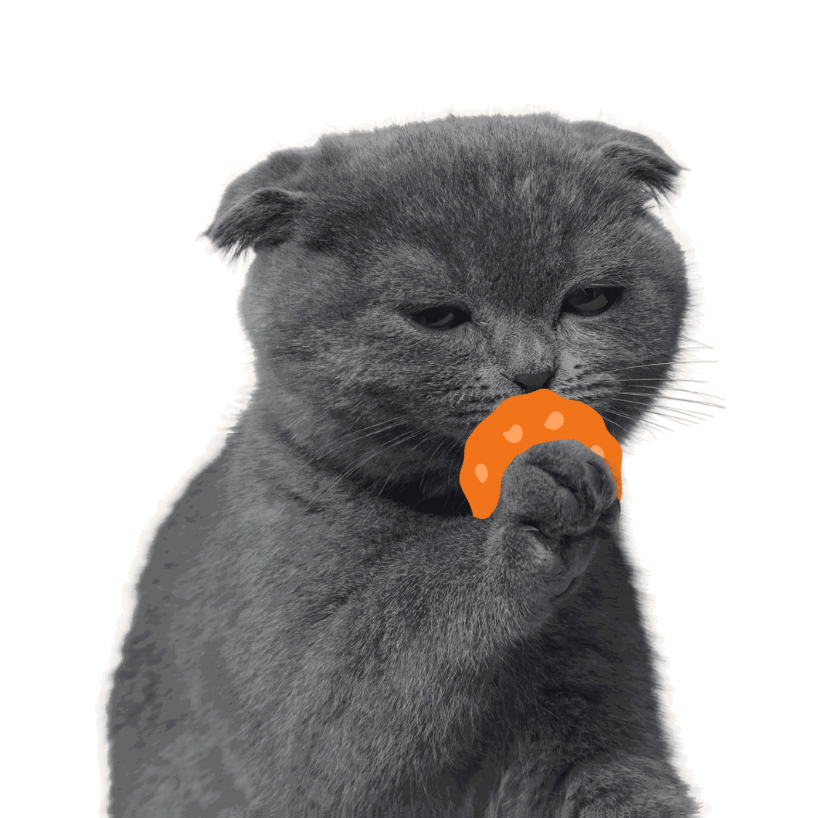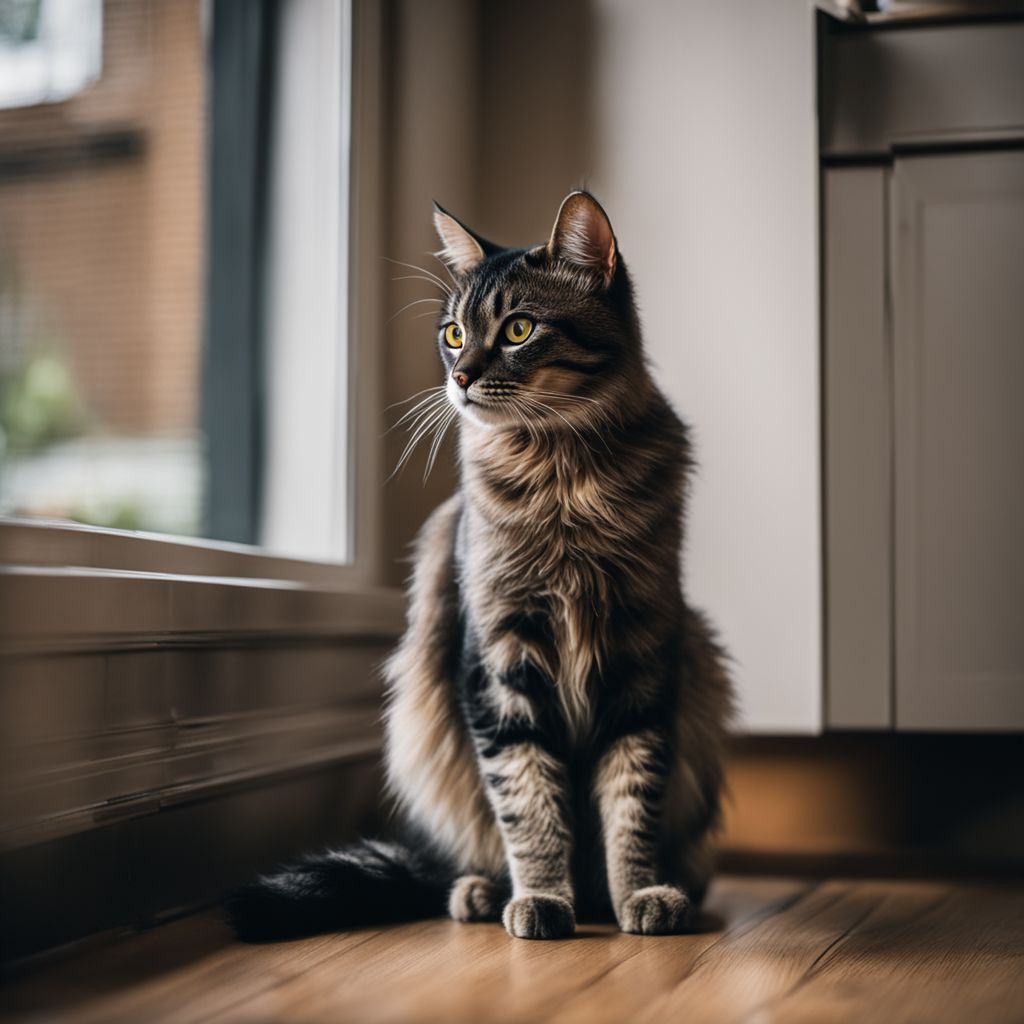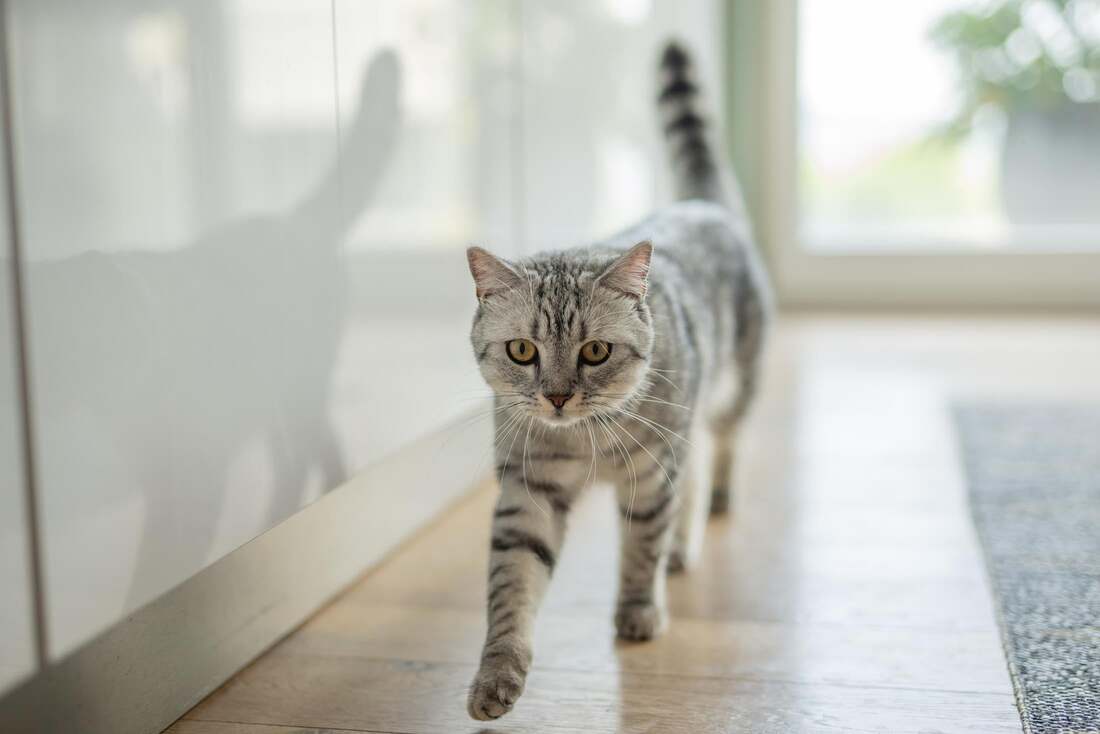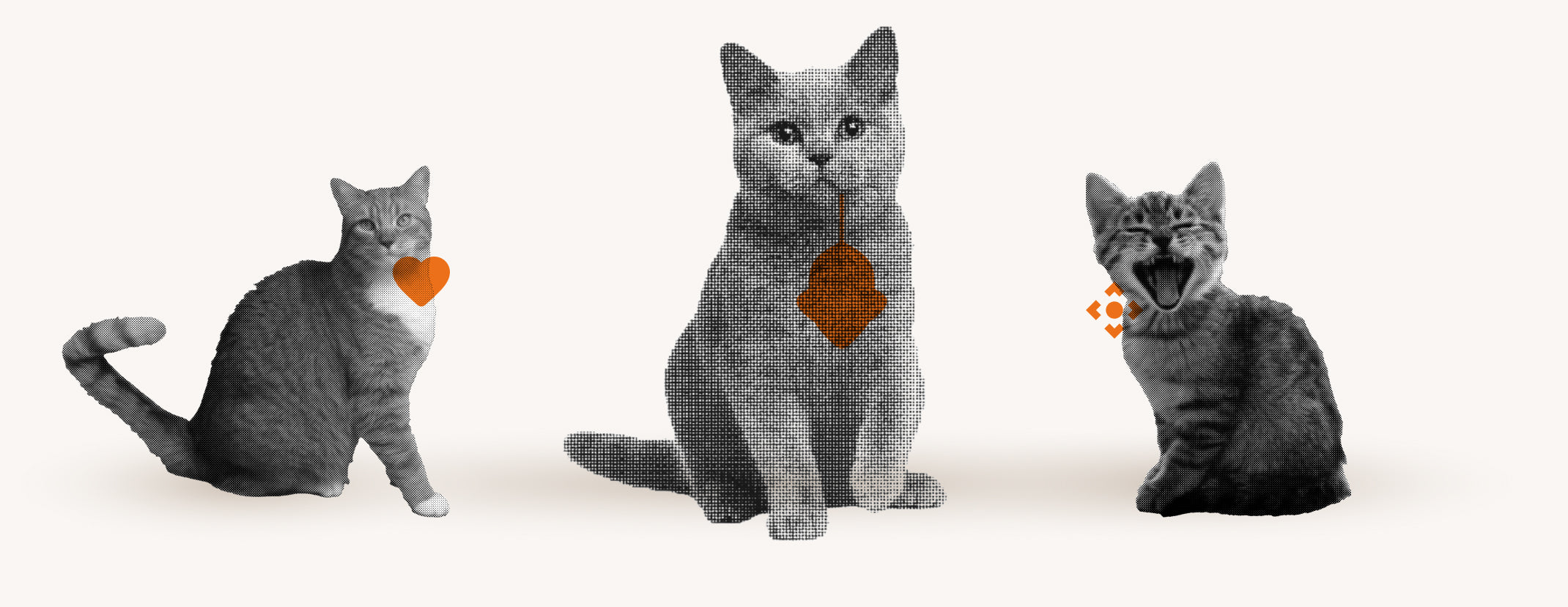Have you ever wondered what your cat is trying to tell you with its behavior?
The mysterious world of cat language can often be puzzling and confusing.
Pictures of cat body language help us understand their signals and respond to their needs.
In this blog post, we delve deep into cat language and learn how to interpret the body language of our furry friends in order to build a closer bond with them.
Importance of Body Language in Cats

Body language is crucial for communication in cats. They use their bodies to express emotions such as contentment, fear or aggression. If you learn to understand your cat's body language, you can better respond to their needs and strengthen your relationship.
Pictures can be very helpful in learning the body language of cats:
- An upright tail position can mean joy.
- Flat ears often indicate fear or aggression.
- Slow blinking can be a sign of trust.
It is important to look at the signals in context . A cat that twitches its tail can be excited or irritated - it depends on what is happening in the environment. By correctly interpreting your cat's body language, you can avoid misunderstandings and promote harmonious coexistence.
Understanding the Basics of Cat Language
To understand the basics of cat language , it's important to know a cat's body language . Cats communicate their feelings and needs in a variety of ways, often through subtle signs that can be easily missed. A cat's body language can reveal whether they're feeling threatened, relaxed, ready to play, or annoyed.
Some key body language signals you can observe are:
- The position of the tail : A tail carried upright usually signals contentment, while a tucked tail can indicate fear or submission.
- The position of the ears : Forward-facing ears often indicate curiosity or attention, while flat ears can be a sign of fear or aggression.
- The eyes : Slow blinking can be an expression of trust and affection.
However, it is crucial to interpret body language in the context of the overall situation . The same behavior can mean different things in different situations. By observing and understanding your cat's body language over time, you will learn to correctly decode their messages and respond to their needs.
Body Parts and Their Signals

A cat's tail position is a telling signal. A tail held high often means the cat is happy and content. A tail that is curled stiffly downwards or tucked between the legs indicates fear or submission. If the cat lashes its tail or moves it vigorously, it is a sign of excitement or anger.
The cat’s ears are also indicators of its mood:
- Ears pointing forward indicate attention and interest.
- Ears that are flat or turned back can indicate fear, aggression or discomfort. The eyes provide further clues:
- Wide-open eyes with large pupils indicate excitement or fear.
- Half-closed eyes or slow blinking indicate relaxation and trust.
Last but not least, the body posture speaks volumes about the cat's state of health. A relaxed cat often lies stretched out or curls up, while a tense or anxious cat makes itself small or even hunches its back. Each of these postures is a piece of the puzzle in the overall picture of cat communication and helps you to better understand your pet and respond to its needs.
Recognizing Emotions: Fear and Joy in Cats

Cats use their body language to express a variety of emotions, and two of the more easily recognizable feelings are fear and happiness. When a cat is afraid, it will often show this through ears laid back , dilated pupils , and a tucked tail . Sometimes, it may also try to make itself small or hunch back to appear larger and more threatening.
In contrast, a cat signals joy in an open and relaxed manner. Signs include:
- A high raised tail , often with a slight curve at the tip
- Relaxed ears and eyes
- Purring , rubbing against objects or people and playful behavior
It's important to consider the context in which these signals occur, as cats are complex creatures and the same body language can mean different things in different situations. For example, a cat twitching its tail might be excited, but in a different context it could also be a sign of anger or fear. Observation and experience will help you better understand your cat's emotional language and respond appropriately.
Communication between cat and human

Cats often communicate with people in a very special way . They use not only their body language, but also sounds such as purring and meowing to express their feelings and desires. For example, if a cat slowly blinks its eyes, this can be a sign of affection and trust. It is important to recognize these signals and interpret them correctly in order to build a strong bond with your cat.
The word "no" is not directly present in cat language, but cats have their own ways of setting boundaries . When a cat hisses, lashes its tail, or retreats, it is showing that it does not like something or is uncomfortable. As a human, you can pay attention to such signals and learn to respond respectfully :
- Hissing often means a clear "no"
- Backing away or tail whipping can also signal rejection
- In response, you can communicate with a firm but gentle voice and clear body language
The better you understand your cat's language, the more successful your communication with it will be. Pay attention to the little things , like the way it twitches its tail or pins its ears back. These signals are part of its language and will help you understand its feelings and needs. By learning to respond to your cat's nonverbal signals , you can build a deeper and trusting relationship with it.
How your cat shows joy

A happy cat shows its joy in many different ways. Look for playful behavior , such as chasing toys or playfully catching objects. This is a clear sign that it is happy and enjoying life. If it wiggles its rear end just before it starts to jump or run, this is an expression of anticipation and fun.
Your cat's body language can also tell you a lot about their emotions. Signs of happiness include:
- A high raised tail , often with a slight curve at the tip
- Relaxed ears and half-closed eyes
- A slight twitch of the whiskers or a relaxed "tread" of the paws
Not to be forgotten is purring , which is often considered the happiest sound a cat can make. When your cat snuggles up to you and purrs, it is a strong sign of contentment and trust . Gentle blinking is also a loving greeting from your cat, showing that it feels safe and secure around you.
Curiosity and Interest: Body Language of Explorers

When cats are curious or interested, they show this very clearly through their body language. Their eyes are wide open and the pupils may be narrow when they are focusing on something specific. The ears are pointed forward alertly and the whiskers are extended, indicating that the cat is eagerly following the source of its curiosity.
The posture of a curious cat is often stretched out and directed towards the object of its attention. Typical signals include:
- The body is tilted low to the ground , ready for action
- The hind legs are pulled under the body in preparation for a possible jump
- The tail is straight and lowered or may twitch slightly, signaling high concentration and preparation for movement
When you are the center of your cat's attention, she may send you other signals. She may snuggle up to you or rub her head against you while holding her tail high and erect . These are signs that she is not only curious, but also asking for your attention or for food and petting.
Recognizing Discomfort and Pain in Cats

If your cat is uncomfortable or in pain , he may show it in subtle ways. Changes in behavior or posture are often the first signs that something is wrong. For example, a cat that is normally very active might suddenly spend a lot of time hiding or moving less.
There are specific physical signs that may indicate discomfort or pain:
- Limping or difficulty jumping
- Altered posture , such as a hunched back
- Neglect of coat care or excessive grooming in a particular area These symptoms should not be ignored as they may indicate health problems that may require veterinary treatment .
Mood changes can also be a sign of discomfort. A cat that is usually friendly and sociable may suddenly become withdrawn or even aggressive . Such behavioral changes are important clues that should not be overlooked. It is crucial to pay attention to these subtle signals to ensure your cat's well-being and to act in time.
Aggression and Defense: Interpreting Warning Signals Correctly

Aggression and defensiveness are important signals that your cat sends to express discomfort or fear. If your cat flattens its ears or tucks its tail under its body, it is exhibiting defensive behavior. This can be an indication that it feels threatened and is ready to defend itself.
In case of offensive aggression, your cat shows a different posture:
- The ears are pricked up
- The tail is fluffed up and moves
- The posture is upright These signals mean that your cat is ready to attack and should not be further provoked in this state.
To deal with an aggressive cat, it is important to be calm and cautious . Give your cat space and avoid direct eye contact, which can be perceived as a threat. Slow movements will help calm your cat and prevent the situation from escalating. If your cat frequently displays aggressive behavior, it is advisable to consult a veterinarian or behavioral expert.
Play and hunting behavior: body language during fun

Cats often display similar behaviors when playing and hunting , but there are subtle differences in their body language. A playing cat appears relaxed and interested , its movements are fluid, and it often adopts a playful posture , such as standing on its hind legs or hitting a toy with its paws.
Body language when playing can have the following characteristics:
- Slightly open eyes and dilated pupils , signaling curiosity and attention
- Protruding whiskers indicating increased concentration
- A slightly moving tail that expresses anticipation and desire to play
In contrast, the body language when hunting is more focused and intense . The cat is highly concentrated , its eyes are fixed on the prey, and it moves quietly and carefully to avoid being discovered. A stretched body and flat ears are typical of hunting behavior, as they help the cat to prepare for the attack.
Love and affection: How your cat loves

Cats often show their love and affection in subtle ways that can easily be overlooked. If your cat often stays near you or tries to make contact with you by nudging you with its nose or rubbing against your legs, these are signs of affection. Bringing small "gifts" such as toys or even small prey items can also be a sign of love.
There are also certain behaviors that indicate a cat's love:
- Purring when she is with you
- giving head butts , which can be considered a kitten kiss
- Treading with the paws on your lap These gestures are their way of saying, "I feel comfortable and safe with you."
Last but not least, slow blinking is a well-known sign of love and trust in cats. If your cat looks deep into your eyes and slowly closes and opens its eyelids, you can interpret this as a kind of hug. It is a sign that it trusts you and sees you as part of its family.
Stress and Anxiety: Body Language in Difficult Times

Stress and fear are negative emotions that cats express through specific body language. Flattened ears, pulled-back whiskers and wide-open eyes are classic signs that your cat is not feeling well. These signs can mean that your cat feels threatened or overwhelmed and are a cry for help that you should take seriously.
Cats are creatures of habit and don't like change. If you notice your cat changing their routines or behaving differently than usual, it could be a sign of stress. Here are some behavioral changes to look out for:
- Sudden scratching of furniture
- Hiding in unusual places
- Urine marking in the apartment
To help your cat, it is important to find and eliminate the cause of its stress. This could be a new person in the household, a move or changes in its environment. If you have several cats, get to know each one well so that you can recognize stress symptoms early and react accordingly. This way you can help your cat to feel safe and secure again.
Relaxation and well-being: signs of satisfaction

A cat that is relaxed and comfortable shows this through its entire body posture . You can tell that a cat is happy because it likes to stretch out or rest in a relaxed position. Its movements are fluid and unhurried, which is a sign that it feels safe in its environment.
The eyes and ears of a happy cat provide further clues to its well-being:
- Half-closed eyes indicate relaxation
- Slow blinking can be a sign of trust and satisfaction
- The ears are relaxed and mostly point forward, indicating interest in the surroundings but without signs of stress
Another clear sign of a cat's well-being is treading or milk treading . This behavior is a relic from kittenhood and shows a deep sense of security. So if your cat treads on your lap with its paws, you can be sure that it feels completely comfortable and enjoys spending time with you.
Illness and Discomfort: Body Language Signs

If your cat is sick or feeling unwell , it may show this through various body language signs. For example, it may be less active and withdraw more often. A change in eating or drinking behavior can also be an indication that your cat is not well.
Pay attention to specific behavioral changes and physical symptoms :
- Limping or difficulty jumping
- Altered posture , such as a hunched back
- Neglecting coat care or excessive grooming in one area These signs may indicate pain or discomfort and should be taken seriously.
Mood changes are also important indicators. A cat that is usually friendly and outgoing may suddenly seem withdrawn or irritable . If you notice such changes, it is important to be alert and, if necessary, consult a veterinarian to determine the cause of your cat's discomfort.
Territorial Behavior: The Body Language of Territorial Claim

Cats are very territorial animals and use their body language to make their territory clear. When defending their territory, a cat will often adopt an upright, wide-legged stance to appear larger and more threatening. They may also puff out their tail and raise their fur to maximize their presence.
There are certain behaviors that a cat displays when marking its territory:
- Rubbing the head on objects to leave scent marks
- Sharpening claws on trees or furniture, which not only maintains the claws but also leaves visible marks
- Urinating in strategic places to leave scent marks that warn other cats
When a cat encounters an intruder in its territory, it will often display aggressive body language . Its ears are laid back, its back is arched, and it may hiss or growl. These signals are clear warnings that it is ready to defend its territory and should be respected by other cats and people.
Make your home cat-safe with Flappie
Flappie offers an innovative solution to a problem that many cat owners are familiar with: unwanted prey brought home by cats. With Flappie's smart cat flap, the home becomes cat-proof and remains free of mice, birds and other small animals. The flap uses modern AI technology to scan cats as they enter and prevent them from bringing prey into the house.
The advantages of the Flappie cat flap are numerous:
- Selective access control prevents cats from entering with prey.
- Prey detection through camera and AI technology.
- A remote control app that provides notifications, videos and statistics so you can always see what your cat is doing and be in control, even when you're not at home.
Do you want to make your home cat-proof and at the same time give your cat the freedom it needs? Then the Flappie cat flap is the perfect choice. Visit https://flappie.ch now and learn more about the intelligent cat flap . Take the first step towards a clean and safe home - without unwanted animal guests .
Frequently Asked Questions
How do cats show fear?
Cats show fear through various behaviors and body language. Signs include ears laid back, dilated pupils, and a tucked tail. Sometimes they make themselves small or hunch back to appear larger and more threatening. Wide-open eyes with large pupils can also indicate fear.
How does a cat show joy?
A cat shows joy by holding its tail high, often with a slight curve at the tip, relaxed ears and eyes, purring, rubbing against objects or people, and playful behavior. A wiggling of the rear end just before it starts to jump or run is also an expression of anticipation and fun.
What does no mean in cat language?
In cat language, a clear "no" is when a cat hisses, lashes its tail, or backs away. These signals show that the cat doesn't like something or is uncomfortable. It is important to pay attention to such signals and respond respectfully.
How does a cat get happy?
A cat expresses happiness by displaying playful behavior, such as chasing toys or playfully catching objects. Other signs of happiness include a tail held high, often with a slight curve at the tip, relaxed ears, half-closed eyes, a slight twitch of the whiskers, or a relaxed "tapping" of the paws. Purring is also often a sign of happiness.





Share:
Training your cat to be an outdoor cat: A comprehensive guide
Keeping Cats Busy in the Apartment: Tips & Tricks